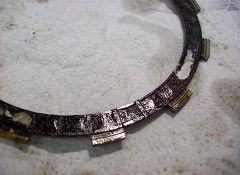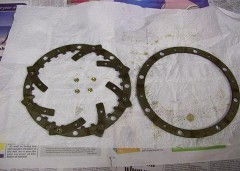WINGOVATIONS
PARTS AND ADVICE FOR YOUR 'OLDEN GOLDIE'



An online source dedicated to Honda's amazing four cylinder Goldwings!
Clutch Plate 'B' Problems
When I was dismantling a '76 engine, in the filter trap and around it there was loads of clutch friction material, along with piles of other garbage.
On dismantling the clutch, here was the reason!
The friction material on several plates had been ripped off!
In the middle of the clutch pack there sits the most horrendous piece of engineering which Honda call 'Plate B'.
It's a clutch damper, two plain plates which sandwich a number of spring steel strips between them to give a cushioning effect to the clutch action.
The steel strips are held by TINY BRASS rivets, one end of each strip rivetted to one plate and the other end to the second plate.
As the strips flex the rivets are either worn through or pulled out of the plates. If you check the above pic you will see the result.
In these pics you can see the results of the one strip which came completely out, ripping into the clutch plate friction material, and another that is only held by one end!
This one on the left shows the components.
As you can see from this picture, when bits of rivet get into the clutch oil scavenge pump, which can easily happen, the pump will jam and cause all kinds of damage; plus the errant steel strip could jam the clutch or the oilpump drive chain etc.
I can't even see the reasoning behind having this abomination. There is enough slack in a chain primary drive to give some cushioning plus the output shaft has a spring shock absorber, so this just seems like overkill to me.
So, if you've got to do the clutch, do yourself a favour and heave this thing into the nearest bin.
Of course, that then leaves the clutch pack short of the thickness of the damper.
Easily remedied! The plain plates are just a tiny fraction thinner then the damper, so purchase two extra plain plates, but be careful where you fit them.
One goes into the centre of the clutch pack, in place of the damper plate, the second is fitted at the back of the pack.
It needs to go here, directly onto the spring carrier. This is double good as it provides a steel surface for the first friction plate instead of the alloy of the spring carrier.
1975 1976 1977 1978 1979 1980 GoldWing 1981 1982 1983 1984 1985 1986 1987
WinGovations Copyright 2010
J G Evans
Addendum
Something interesting came up whilst I was over in the States this year. In the course of replacing the clutch on one of his engines, Steve Seamans noticed that the Plate B that came out had internal teeth on both the plain metal side plates!
This is obviously what should have been the correct design right from the beginning, as now the spring plates and rivets only have to provide the cushioning effect that they were intended for, and do not have to transmit any torque at all.
It would seem that Honda realised that there was a problem and brought out this modification for the 1977 model GL1000. I have three early GL1000 clutches sitting here; all three have the original single toothed B plate. All three will be going in the trash.
So if you have one of these modified plates, you may want to keep it, except for one thing; strangely, the rivets that hold the spring steel straps are still made from brass in the later one. Not the best engineering solution!





